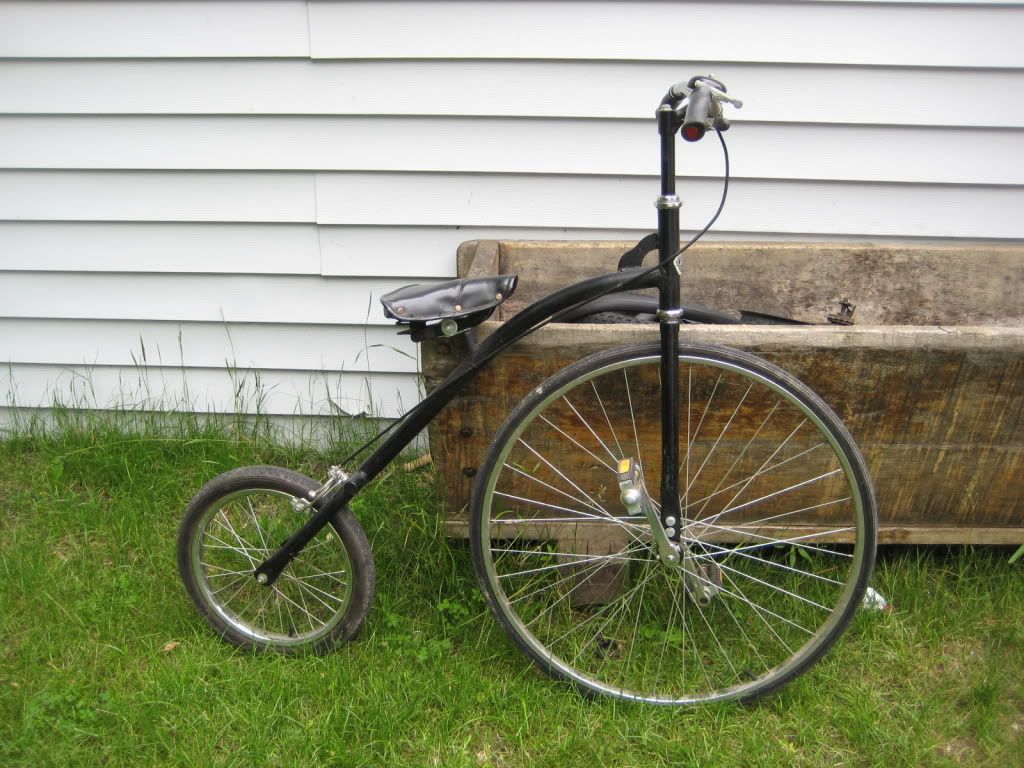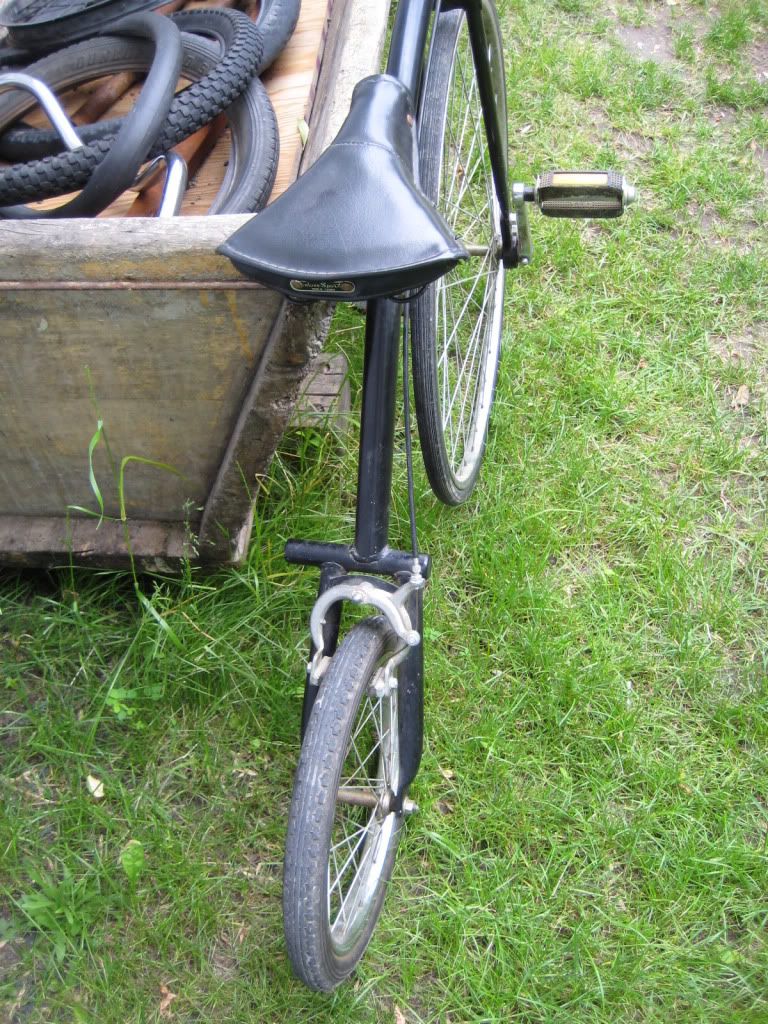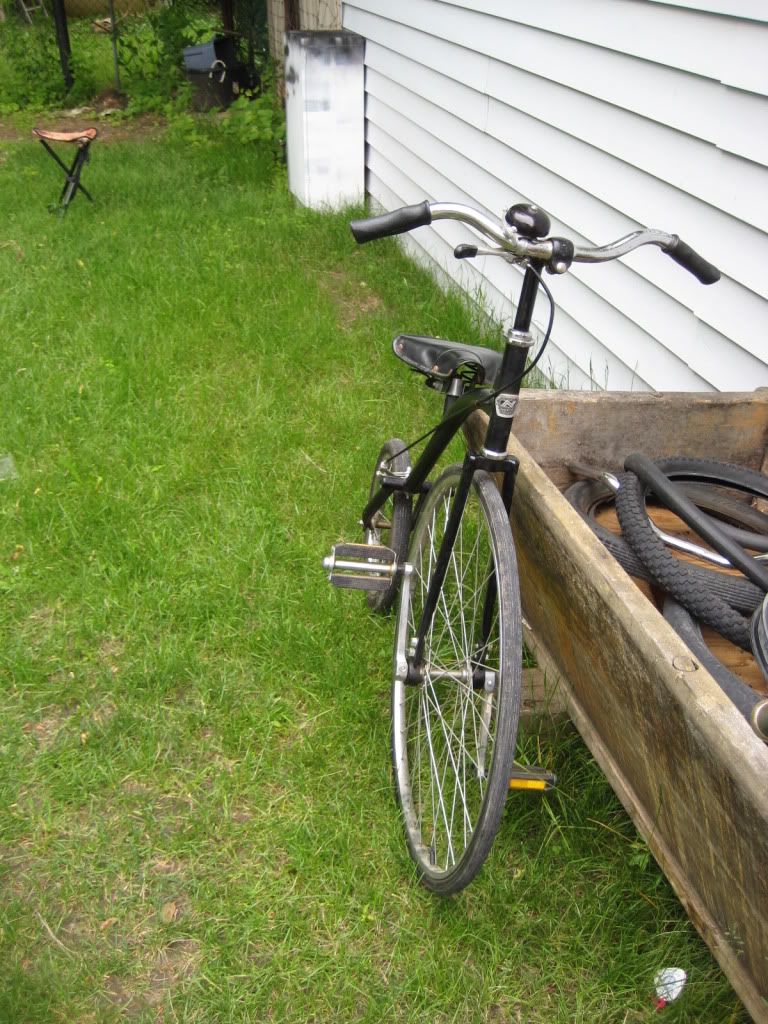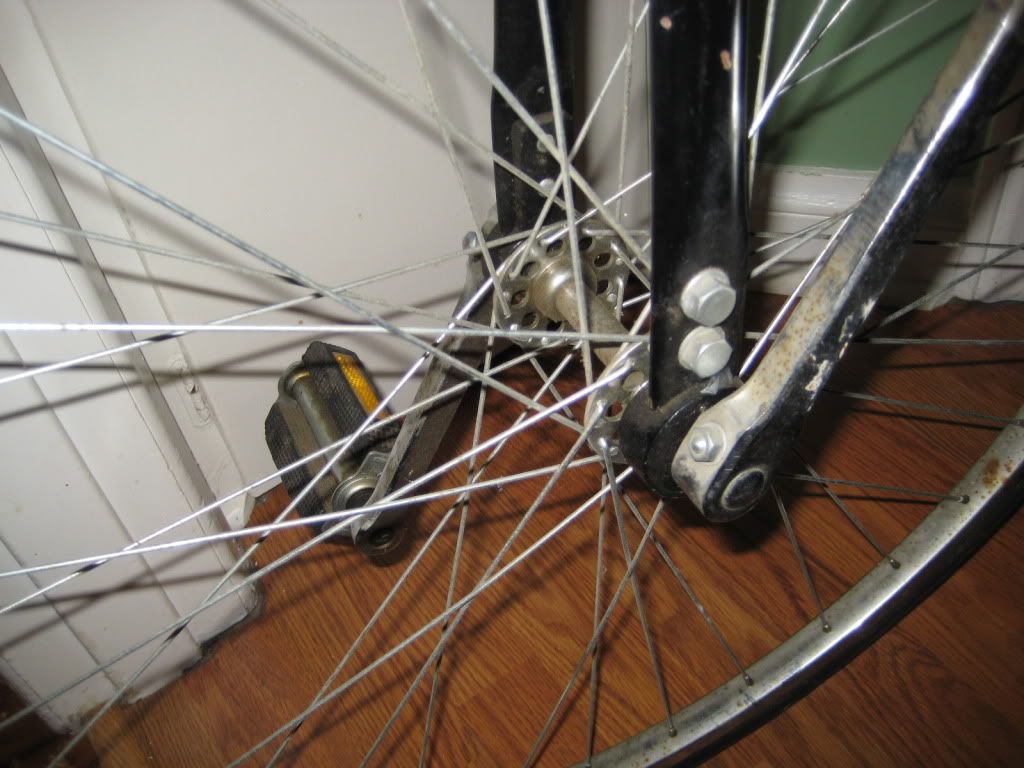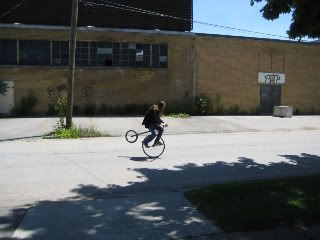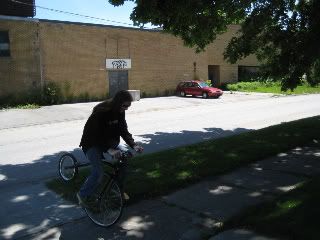You are using an out of date browser. It may not display this or other websites correctly.
You should upgrade or use an alternative browser.
You should upgrade or use an alternative browser.
Are there any home-built Penny Farthings here?
- Thread starter Beau
- Start date

Help Support Rat Rod Bikes Bicycle Forum:
This site may earn a commission from merchant affiliate
links, including eBay, Amazon, and others.
I've been thinking of the one I saw on American Pickers that was reversed... Small wheel up front. It looks really neat to ride. If you build one I'd like to know what you think on how hard the build was and how the ride is.
Sinner4 said:
I saw that. Pretty cool.
I'm going to buy some C-channel and roll my own rim.
From the little bit of info I have found, I know the fork/headtube needs to have a 1* rake. I'm just interested in knowing other common knowledge about building these.
I like the idea of the hiwheel with the little wheel up front, but I think I'd rather fall forward than backward.
ChopperOlli did one. He manf most of the parts him self. Here is the thread viewtopic.php?f=6&t=7343&st=0&sk=t&sd=a&hilit=ordinary ( most pics are gone but a few left)
His website. http://www.ollierkkila.com/
His website. http://www.ollierkkila.com/
I built a pretty ghetto pennyfarthing, but it's still fun to ride 
http://www.ratrodbikes.com/forum/viewtopic.php?f=10&t=18310
http://www.ratrodbikes.com/forum/viewtopic.php?f=10&t=18310
http://peugeot.mainspot.net/penny-farthing.htm said:The ordinary is a direct-drive bicycle, meaning that the cranks and pedals are affixed directly to the hub. Instead of using a relatively complex and heavy gear system to multiply the revolutions of the pedals, the driven wheel was enlarged to its maximum radius -- up to a length close to the rider's inseam -- to increase the maximum speed. This shifted the position of the rider upward, placing him nearly on top of the wheel. This meant that the rider's feet could not reach the ground while riding, making it effectively little more than a unicycle with an extra wheel for stability.
Peny-farthingThe frame is a single tube following the circumference of the front wheel for around 1/4 arc, then diverting at a tangent to a fork in which is mounted a small trailing wheel. A mounting peg is attached above the rear wheel. The front wheel is mounted in a rigid fork with little if any trail. A spoon brake is usually fitted on the fork crown, operated by a lever from one of the handlebars. The bars are usually moustache shaped, dropping down from the level of the headset. The saddle mounts on the frame somewhat less than 0.5m (18") behind the headset.
Mounting a wheel is a process requiring some skill. One foot is placed on a small peg on the frame above the back wheel. The rider then grasps the handlebar, scoots using the other foot, and when sufficient speed has been gained to effect balance, lifts himself (almost all high-wheel riders were and are men) into the saddle.
Although very stable due to the pendulum effect, the penny-farthing was notoriously prone to accidents. To slow and stop a high wheel, as with a fixed gear bicycle, the rider applies a backwards pedaling motion, augmented by use of a spoon-shaped brake pressing on the tyre. The center of mass being both high and not far behind the contact point of the front wheel meant that any attempt to stop suddenly, or any collision with a large pothole or other obstruction, would be likely to send them flying over the handle bars (known as "taking a header" or "coming a cropper"). On long downhill stretches it was recommended that riders take their feet off the pedals and hook them over the handlebars, so that in case of a crash they would land (hopefully) on their feet. This made for quick descents but left almost no chance of stopping should the need arise.
Nice! Please let me know what you find for materials.
I also realized something quite useful. I have found many bikes running 72 spoke wheels. I plan on making my own hub and realized tonight that with 36 holes per flange, that simply means there is a hole every 10 degrees. Brilliant!

I also realized something quite useful. I have found many bikes running 72 spoke wheels. I plan on making my own hub and realized tonight that with 36 holes per flange, that simply means there is a hole every 10 degrees. Brilliant!

Well, so much for getting the tire locally. The people at the industrial supply house have no idea what kind of hose is being used.I'm thinking of looking at some hose used to replace a/c lines on cars and trucks. We don't sell it at the auto parts store I work at, but I think Napa stores carry it. I think it is thick , like what is described in the articles.Let's keep this going .I'm excited about this project.Thanks
my grandpa used to have a garden hose made from hydraulic hose material. very impractical, heavy, you couldnt roll it up in a normal size circle. but there was absolutely no way you were gonna kink that sucker!  this thread made me think of that, maybe a possibility for your tire?
this thread made me think of that, maybe a possibility for your tire?
I checked today at a local hydraulic hose supplier. All the hose they had was either too thin , and would be like having a flat tire, or had wire braid in it. I'm afraid that the wire braid would prevent the hose from spreading and then coming back together as it needs to during installation.Someone suggested hose for a sandblaster, but all I've seen offered is a too-short piece. The automotive a/c hose looks like a better choice. The a/c hose in the right size is $4.00 per foot at NAPA . So the tire cost would be about $40.00.I also checked several places and could not find the #2 die for threading the spokes.My search will resume after Christmas. I now have a new interest in the early hi-wheel bikes and am looking at photos of the closer than ever before.
Yeah, I have no idea what a #2 die is. I ordered 12 gauge/105 spoke nipples and a couple rims to play with. I know that spoke nipples are 56 t.p.i., but from what I read it's not good to "cut" spoke threads and better to roll them.
UPDATE- Phil Wood spoke machines will thread 105g (2.6mm) rod. :lol: This means I need to find 2.6mm rod.
I also found this amazing build! Please keep posting info on these types! I need all I can get.
http://www.thewheelmen.org/forum/topic. ... hichpage=1
I'm gonna order a pair of these tires to cut up-
http://www.jbimporters.com/web/checking ... mber=60307
UPDATE- Phil Wood spoke machines will thread 105g (2.6mm) rod. :lol: This means I need to find 2.6mm rod.
I also found this amazing build! Please keep posting info on these types! I need all I can get.
http://www.thewheelmen.org/forum/topic. ... hichpage=1
I'm gonna order a pair of these tires to cut up-
http://www.jbimporters.com/web/checking ... mber=60307
Custom big wheel / Coker spokes [Re: Coker spoke upgrade?]
Cokerhead <[email protected]> wrote:
>Has anyone checked into getting some custom (stainless) spokes made for
>a Coker? I really don't want to build a new wheel with the existing
>spokes because they turn black within a few months. I got a quote for
>$800 US for a minimum order of 1000 spokes thru a LBS. Would they have
>to be as thick as the stock ones? Any comments?
About twenty years ago, I made 13 gauge stainless steel spokes for 36",
40", 51" and 56" big wheels (obviously none of them were Coker
unicycles). I used 3/32" x 36" stainless steel welding rods for the
spoke material, bent one end to a Z shape with right angle bends (see
more detailed ASCII shape below), cut them to the proper length, and
made threads on the other (nipple) end with a #3 56 (thread cutting)
die.
+---------------+
| |
+-----------+ |
| |
| +---------------------------------------------------
| ...
+-------------------------------------------------------
Flat steel that is about the thickness of the flange placed in a vice
with one or more spoke holes drilled about 1/4" from one edge can be
used to make the above illustrated bend in the flange end of the spoke.
A jig with a spoke hole on one end and a hefty wire cutter welded to the
other end can allow one to make uniform length spokes quite quickly by
hand. Mounting the #3 56 thread/inch die on a reversible electric drill
can make the threading process go very quick. (The wire cutter leaves a
V shaped end - leave it that way - if you need to file it down to avoid
puncture risk, the spokes were cut a bit to long and should be re-cut to
the proper length.)
BTW, 13 gauge (.092") nipples are hard to locate. Schwinn had this size
with a "14 gauge" outside that required a special 14 gauge spoke. This
resulted in rather thin nipple walls that required the tighter fitting
special 14 gauge spoke wrench, but even this wrench would round out the
square corners of the nipple. It would be better to use the Semcycle 13
gauge nipples that fit a 12 gauge spoke (thicker than normal walls!).
For 36" & 40" big wheels and Cokers, one 3/32" x 36" stainless steel
welding rod can be make into an L shaped "double" spoke. A double spoke
has the Z bend in the middle of the rod with the two ends threaded for
rim holes that are about 105 degrees apart. Making the bend come out at
90 degrees rather than the approximate 105 degrees works out fine.
However, these double spokes require flanges that have half the normal
number of spoke holes and more importantly the flange holes of each
flange must NOT be staggered evenly (1/2 the adjacent flange hole
length); they must be staggered at 1/4 (or 3/4 for the mirror image) the
adjacent flange hole with respect to each other around the axel axis.
Such hubs must be custom made or be antique hubs that were designed and
built for the L shaped hubs of probably about a century ago. (Many
penny farthing designs probably used such hubs and double spokes for the
"penny" [large] wheel.)
It should be easy to apply the above to a Coker with a nipple that fits
the rim you use properly.
The advantage of stainless steel welding rods is they are sold in
straight lengths. A disadvantage is much of 36" rod is wasted, but they
can be custom ordered to a specific shorter or even longer length if the
quantity is large enough. Huge rolls of stainless steel wire could be
used (I didn't investigate this option), but then you have the extra
problem of making them straight enough to cut uniform (precise) and
accurate lengths. (Uniform lengths are useless if they are too short
[very bad] or too long [can be re-cut to the proper length, preferably
not after threading them].
Another option is 12 gauge (.105") rods or wire with regular 12 gauge
nipples. The 3/32" x 36" stainless steel welding rod is very common in
the USA. Please report what stainless steel welding rod sizes are
available in your respective countries. Someone, please report the
metric sizes that are equivalent or close to 13 gauge (.092") and 12
gauge (.105").
I learned almost all the above by visiting, working and talking with Tom
Miller of "The Unicycle Factory". Tom may not have a strong presence on
the WWW, but he does create and sell wonderful and reliable unicycles &
has a good selection of parts as well. Call him at 765-452-2692 and he
may be happy to expand on the above discussion (and even sell you a
unicycle or a few parts).
Sincerely,
Ken Fuchs <[email protected]>
How about pure gum rubber? :lol: $4 per foot.
http://www.pchemlabs.com/product.asp?pid=3176
This looks similar to what this guy has-
http://www.youtube.com/watch?v=q0cLK8DW ... re=related
http://www.pchemlabs.com/product.asp?pid=3176
This looks similar to what this guy has-
http://www.youtube.com/watch?v=q0cLK8DW ... re=related




